
An Essential Guide to Drawing-Based Training
A picture is worth a thousand words.
Visualizations have been a fundamental part of coaching, from cave paintings to the conference room since the beginning. Drawing is a critical complement to almost any guided discussion. I’ve seen firsthand how simple drawings can open up new dimensions in supportive conversations in one-on-one and group settings.
Below, we will ask and answer the foundational questions behind incorporating drawings into your coaching and leadership, including the WHY (logical support), HOW (methods and materials), and WHAT (concrete examples) of this powerful process.
Why Coaches and Trainers Should Draw
The average brain processes visual information much more efficiently than verbal expression. This makes sense, considering visual stimuli significantly predate the earliest forms of spoken language and the written word.
It’s unsurprising, then, that drawing can bring greater clarity to ongoing conversations between coach and coachee. Drawing brings new thoughts and ideas to the surface, and these visualizations can offer unique perspectives when confronting various challenges or difficult decisions. Drawing can help align everyone in a group with a singular vision, and it can be an integral part of mapping and achieving specific goals.
How Coaches and Trainers Should Draw
Drawing-based coaching doesn’t require any sort of artistic flair or natural gift. In fact, when it comes to facilitating supportive conversations with your clients, the “drawing” involved is really no more than guided doodling. Lines. Circles. Rectangles. Arrows. Even the best hand-drawn visualizations use just a few simple components to spur conversation or further examine a supportive topic.
That said, if you have never utilized these tactics before, you may need a bit of practice before the tools and techniques become second nature. You can practice in a controlled setting, such as with yourself or with your friends until you feel more comfortable guiding someone through the entire process. Then, once you begin developing your own identity as a drawing-based coach, you can focus on the answers to two more nuanced questions:
Who should be drawing?
Depending on the tool being used, it may be more typical for the coach or coachee to do the majority of the drawing. However, the drawing duties should be shared equally in most supportive conversations.
What instruments should be used?
Drawing materials are virtually everywhere. While a flipchart might be ideal, the same can often be accomplished with a scrap of paper. While an assortment of colors can make things exciting, any pen or marker with a legible stroke will do just fine. The physicality of drawing is part of its charm, but even digital drawing tools can serve as a worthy substitute.
What Coaches and Trainers Should Draw
There are a host of tried-and-true drawing-based tools (or diagrams) available to everyone. These tools are tailored to specific situations, decisions, and milestones. Some tools will work better for individuals, while others will shine the most in groups. Some tools function as one-off experiences or singular evaluations, while others are designed to be part of a more protracted discovery process.
These tools are part of an ongoing dialogue between coach and coachee, and they should serve to engage both sides of the conversation. It’s important to remember that every step of the drawing process — no matter the diagram being used — begins and ends with a clear understanding of what is on paper.
1. Path relationships
Unpacking what’s changed and identifying incoming challenges helps everyone move forward. These drawings help you and your coachee decide on a detailed route from point A to point B—or C.
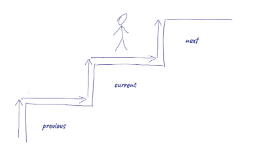
The Next Step (seen above) – Needs to know what’s next?
Stairway – Needs help navigating a challenge?
The Satisfaction Curve – Needs to progress to the next phase?
Tree of Life – Needs to chart a path of personal development?
Personal Solar System – Needs to map and analyze relationships?
Network – Needs to understand conflict within a community?
2. Resource management
Taking stock of your resources and understanding them deeper is a big step forward for everyone’s awareness. These drawings support thoughtful resource management and help you and your coachee easily identify their inherent value:
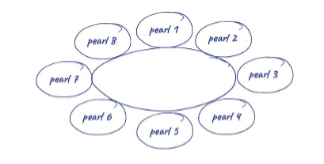
Pearl Necklace (seen above) – Needs reassurance about their tangible value?
Shining Star – Needs to feel noticed and inspired?
Be a Champ – Needs a boost to perform their best?
Greek Temple – Needs more affirmations?
Batteries – Needs to correct a work-life imbalance?
3. Mapping goals
Visualizing your options and thinking methodically about where each might lead is how the best decisions are made. These drawings help you and your coachee map their goals and deconstruct them for closer examination:
Daisy of Options (seen above) – Needs to overcome a specific decision?
Spiderweb of Goals – Needs to prioritize the right goals?
4. Achieving goals
Finding a sustainable workflow and breaking down success into digestible chunks is the only future-proof path to achieving your goals. These drawings are your visualization and assessment of performance when there is a clear-cut result in mind:
Raise the Bar (seen above) – Needs a holistic look at their own success?
Performance Ladder – Needs all the context for one performance?
Lighthouse – Needs guidance toward a complex goal?
Hot Air Balloon – Needs to make changes to succeed?
Spaceship – Needs to course-correct toward their goal?
Cloud to Triangle – Needs help outlining their own success?
5. Making decisions
Working through a specific decision in the right way has a huge impact on the resolution and confidence you find at the end of the process. These drawings help your and your coachee look at each situation from every angle and find peace in what’s decided:
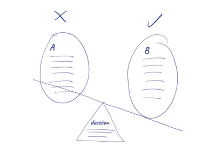
Seesaw (seen above) – Needs to weigh opposing possibilities?
Decision Alternatives – Needs to find the best option among many?
6. Gaining insights
Being able to develop targeted understandings of what’s going on with one’s own career is absolutely essential — effort vs. value, routine vs. innovation, or positivity vs. skepticism. These drawings help give energy to the insights that ultimately push us to evolve as professionals:
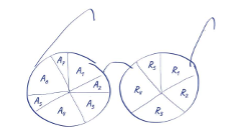
Value-Effort Glasses (seen above) – Needs to know if their effort is worthwhile?
Half Full, Half Empty – Needs to open up to more solutions?
Jug and Mug – Needs to simplify something complex?
Break the Cycle – Needs to look outside of their routine?
Perfectionist – Needs to find acceptance and finalize things?
Stuck in a Problem – Needs to wake up and make a decision?
7. Supporting change
Identifying where and how change is possible is the catalyst to all forward momentum in one’s career. These drawings support you and your coachee with the many stages and elements of meaningful change:
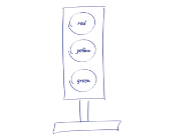
Traffic Light (seen above) – Needs a step-by-step way forward?
Scale of Ten – Needs to know where to go from here?
Change Switch – Needs to try again with extra guidance?
Yes — No, Less — More – Needs to categorize many different changes?
C for Change – Needs to understand one change completely?
Change Clock – Needs to see how change will progress?



